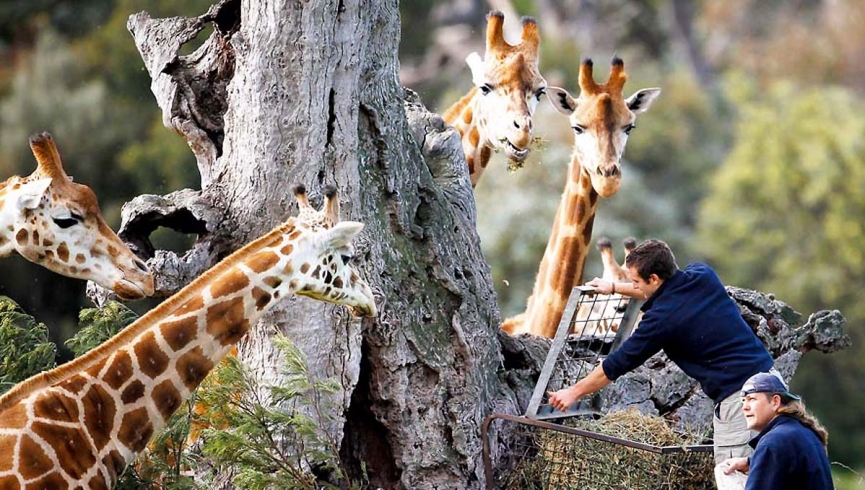She lumbers onto the scales, affecting indifference as the digital display flickers furiously. That’s 200 kilograms … overweight! SiSi, you’re off to the fat farm. If ever a rhinoceros could look chagrined, this was the moment. After all, it is hardly a girl’s fault if the grass is greener on the other side of the globe.
“One of the more surprising challenges we face here is that the soil type is sensational for growing, particularly on the lower savannah, which is down along the river flats,” says Russel Traher, Werribee Open Range Zoo’s general manager of life sciences.
“It means that the grass grown down there – that all the grazers eat – is actually a lot richer than what they would normally get on the African plains.”
It’s an issue, particularly with the rhinos, who munch through 50 kilograms of feed a day to maintain an optimum body weight of 1800 kilograms (female) and 2100 kilograms (male).
PICTURE GALLERY: Behind the scenes at Werribee Open Range Zoo
“They are just programmed to eat like a lawn mower and will just chew away all day and because the grass is so rich they are getting too much,” Traher says.
“So, every now and again, we have to send one or other of them to fat camp, which is up on top of the hill where the grazing is a lot more arid.”
If weighing rhinos sounds preposterous, it’s all in a day’s work for the keepers here at the multi-award-winning conservation park.
While there’s no mistaking it’s the animals who are the stars of the show, a tremendous amount of work goes on behind the scenes to ensure the health and well-being of the collection. More than 100 volunteers are involved in the zoo’s operations, from front-gate guide services through to preparing “enrichment” boxes and bags containing favourite treats to help keep primates and meerkats mentally stimulated.
Then there’s the specialist staff like horticulturist Enrique Ramirez, who is one of the team responsible for flora across the 235-hectare site, including the important browse plantation.
The plantation, which contains 16,000 trees, mostly propagated on site, is a veritable smorgasbord of 30 different species ranging from acacias, from which giraffes are each fed three to four branches a day, to hibiscus plants much favoured by the leopard tortoise.
Fresh fruit and vegetables are a major component of the diets of the primates and herbivores and also supplement the diets of omnivores, like the meerkats.
“Our buyer of fruit and veg goes to the Melbourne Market, same as your greengrocer and buys human-quality fruit and veg,” Traher says.
Zoo buyers purchase between 25 and 35 boxes of fruit and vegetables each week, including eggplant, capsicum, sweet corn, carrots and leafy greens like chicory and silverbeet that make up the gorillas’ breakfast.
But rather than dish it up on a plate the food is hidden through the exhibit, encouraging the gorillas to forage as they would in the wild.
“When you think about it, most of the animals we have here have to work their butts off in the wild to get food – so that level of activity is quite normal,” Traher says.
“Every animal has an enrichment program, aimed at maintaining their physical and mental fitness.”
Hence the lions, cheetahs and servals go through training sessions to simulate natural hunting behaviours.
“We won’t use live animals, but we do use a lure – kind of a bit like what you would see at a greyhound track. It’s good because it exercises them, keeps their joints supple and allows them to hone skill, but it also keeps them motivated.”
In addition to the $60,000 annual meat budget, the zoo buys in crickets and mealworms for the vervet monkeys, meerkats and prized population of Eastern barred bandicoots. Another speciality item on the shopping list at present is formula for a baby of a gargantuan kind.
Kipenzi, the white rhino calf born in May, is being hand-reared because of her mother SiSi’s refusal to let previous calves feed. The calf, now weighing 170 kilograms, consumes 21 litres of custom-made milk a day, and must be taught the necessary rhino social skills before she can safely take her place among the herd.
But while rhinos are at the top of the tree in terms of food access, you can’t go past a zebra for sneakiness. Night vision cameras placed in the mixed-herd enclosure of zebra and kudu revealed the shorter zebras had figured out a way to access the taller antelopes’ food.
In the zoo business that could be called earning your stripes.







